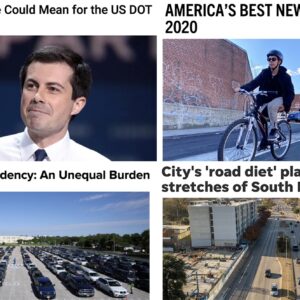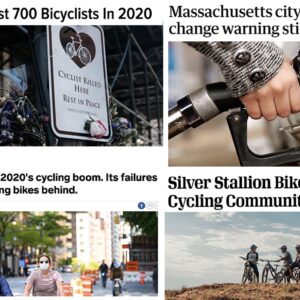Here is the news that caught our eye last week:
– At December’s summit on climate change in Copenhagen, Saudi Arabia is planning to push hard for wealthy countries that successfully reduce oil use to compensate oil producing nations.
– US Rep Earl Blumenauer (representing Portland) has just announced a federal Livable Communities task force. Meanwhile, the NY Times has a big profile Earl Blumenauer, focusing on his fight for a health care bill with a public option.
– Streetsblog refutes a disingenuous take on congestion pricing by the Wall Street Journal.
– An interesting look at Orenco Station, Hillsboro’s famous example of a transit-oriented development community. Residents use their car less and take transit more than other suburban residents, but their commutes to work are still largely by car.
– USA Today reports on a trend in “eco-friendly” parking garages.
– In Oregon, Metro is recommending that the Urban Growth Boundary not be expanded in 2010.
– A local architecture firm has proposed an innovative solution for creating walkability in the wavy, disconnected residential streets of Tigard, Oregon — just bypass the street system.
– Construction of a pedestrian bridge that would connect Portland’s South Waterfront Development with the neighborhoods west of the freeway is delayed yet again as a round of bids comes in well over budget.
– In Utah, developers and cities want to create walkable areas — but banks are reluctant to lend the money.
– DJC Oregon reports on the connection between street layout and public health.
– The Google Maps Trike team (we wrote about it most recently here) is accepting requests for where to send the trike next, either in the Portland region or farther afield.
– If you take your folding bike on Air Canada, you must pay the same fee as for a full-sized bike, the government has ruled.
– A new level of regulation is coming to New York City’s pedicabs; meanwhile an internet video of a brawl between a pedicab operator and a taxi driver is making waves; and the NY Times columnist sees cause to ban automobiles from Manhattan.
– Minneapolis is experiencing growing pains with their new cycle track on Hennepin Ave, which has also been redesigned to allow two-way traffic.
– In Oakland, California, transit advocates have experienced a lot of ups and downs, but are making a lot of progress lately, according to a blog post that details the ins and outs of some of the major issues.
– The Cascade Bicycle Club is pushing for a law to protect vulnerable road users in Washington State.
– Chinese police may soon begin to penalize the passengers of drunk drivers.
– California first lady Maria Shriver has been caught on camera three times in recent weeks using a hand-held cell phone while driving — a practice that her husband has outlawed.
– As we remember two fatal right hooks in Portland two years ago, news comes from California of a fatal collision between a woman on a bicycle and a right-turning truck. No consequences appear to have resulted for the man driving the truck, and a chorus of voices blame the woman on the bicycle — who was obeying the law at the time of the crash.
– Researchers who conducted a study on bike crash injuries in a trauma ward in Denver warn of a coming “injury epidemic.”
– Economically, bike manufacturers are doing better than car makers — but this isn’t true across the board.
– Art students at NY’s Cooper Union have found an innovative workaround to the unfriendly bike parking policies at their campus’s new LEED Platinum building.
– And finally, the video of the week. Not recent, but timeless nonetheless — a quick view of what it takes to walk across the street in Ho Chi Minh City, Vietnam. (For a more upbeat alternative, check out this scene from Portland.)





saudi arabia; so many eggs in one tiny basket. i look forward to the day that entire region crashes. hard.
Saudia Arabia, you want my money because I don’t use your oil? Hahahahahahahahahahahahahahahahahahahahaha.
Hahahahahahahahahahahahahahahahahahahahaha.
Hahahahahahahahahahahahahahahahahahahahaha.
There. I feel better.
Oh, and no. You can’t have it.
mavic is about to go under as well…
the economy isn’t all peachy on the bike industry…
The economy isn’t all that peachy to a bike company that builds $1200 exploding rims.
the usa toady story lends itself to so many questions, looking at the comments, i searched ‘bike’ and ‘bicycle’ and found no mention. instead of $40K per space parking structures, bike parking at transit stations seems to be such an easy solution,and a cheap one. But no one seemed inclined to mention it. I would have,but having to subscribe to their site puts me off.I would then be added to their readership numbers.
maybe I will have to rethink not subscribing to their site… think of all those readers we could influence. anyone else up for it?
On that bike injury article, they mention helmets. But from the extent of the injuries they list, and considering 1. only 39% had head injuries, and 2. bicycle helmets are only designed to protect at 12.5 MPH and are essentially useless by 20 MPH, I would say reducing speed limits would be a better way to reduce injury and death.
Talking with the motorcycle people their experience has been that helmets saved about 20% of the people that had head injury, but the survivors still had severe brain damage. Many were of the “moss for his north side for Xmas” variety, but most were like me, alive but no longer able to work.
Opus, here’s the sentence about head injuries from that article:
“Cyclists themselves appear to be part of the problem: Helmet use did not go up over the study period, and more than 33 percent of 329 injured cyclists had a significant head injury.”
The sentence doesn’t say how many of those 329 injured cyclist weren’t wearing helmets. A closer look at the study once its available might be worthwhile. If, as part of the study, the injured cyclists were interviewed to learn about the circumstances of the crashes they were involved in, that might help to learn something about real world efficacy of bike helmets.
Regarding a different Monday Roundup item, I found the Salt Lake Tribune article to be a fascinating read. To think that developers can actually be persuaded to propose walkable development designs, and then the banks won’t give them the money for them… . Still, just getting developers to consider such developments seems to be a step forward, and away from car dependency and parking lot addiction.
The Oregonlive.com article about Orenco resident car-to-work use was also very interesting. Some good comments in comments section too. I learned a few things there.
Intel’s campus (one of them)is apparently a half mile from Orenco. How many of Orenco residents employed at Intel commute to work by means other than SOV’s?
The Lewis & Clark U professor’s study that the Oregon article cites, does not answer this question, yet, some of the people commenting to the O’s article are very aware of this particular live-work question relative to Orenco. Is the professor’s study accurately indicating that Orenco residing Intel employees are driving a half mile to work in SOV’s?
Wsbob:
I used to commute to Intel’s Ronler Acres campus, and would use the Orenco Max stop. Biking between the two is easy enough, but you don’t see many people do it. Orenco is pretty much plopped down on the site without context. Dense enough, but not really connected to the adjacent neighborhoods. And, the four-lane roads that split everything up kill what connectedness there is. It’s sure gonna be tough to fix the suburbs!
Slate.com had an article by Christopher Beam published last Friday, October 16: Stop Means Stop | How do we get bikers to obey traffic laws?.
It’s fairly rudimentary, meaning it sounds like the state of the debate in Portland from about 3-4 years ago, but it’s probably decent indicator of where things are nationally. It’s easy to forget how far ahead Portland is while you’re living here, so it’s worth a read if you’re interested in national advocacy.
“It’s sure gonna be tough to fix the suburbs!” peejay #8
I think that’s right. I can see this around my own neighborhood in central Beaverton. Over the last decade or so, the city has done some fine work installing bike lanes and paths, yet moving about the city between it’s key points by foot, bike, or even mass transit is not an inviting experience;big 4 lane roads have something to do with this.
Orenco, on the other hand, is an almost new, planned from the ground up community. There, I would have thought that planners would be aware of reasons community residents would have reservations about walking, biking, or taking mass transit a half mile to work or school, etc, and put into their designs, measures that would overcome those reservations.
A half mile is just not that far to walk…In Portland, a walk from W Burnside, south to PSU is about a half mile…I’ll say this: a very nice walk too…world’s apart in terms of quality experience, comparing a similar length walk from where I live, in central Beaverton to the Beaverton Library.
wsbob:
Orenco can only plan inside its perimeter. The rest is beyond its control, which is why it fails as a livable community right now. There just isn’t the population density there for Orenco to be self-sufficient: they have a couple of restaurants and a couple of stores in the “downtown” part of it, so, clearly, people rely on the surrounding area to provide most of their needs. It’s great that you can walk to the train, but downtown Portland’s too far away to fill everything that’s missing. This is what happens when a local government cedes all planning decisions to the private sector. Even when one developer makes an effort, if nobody else does, it doesn’t make a difference.